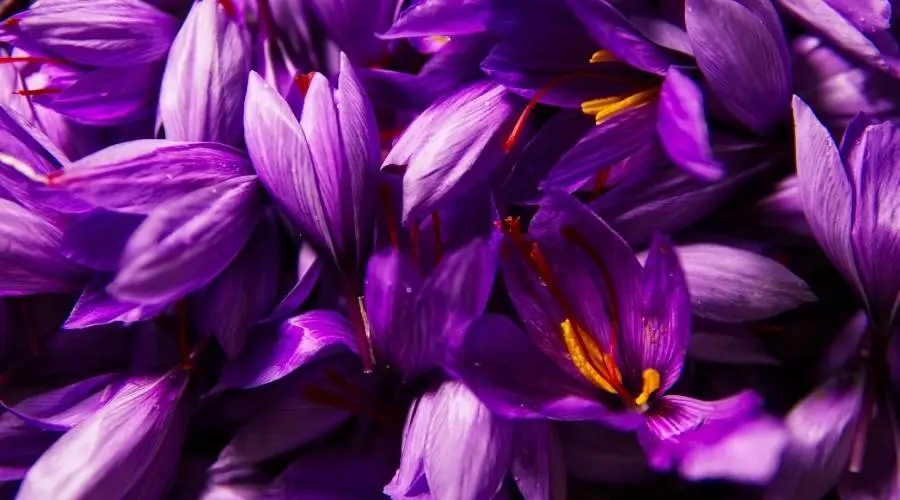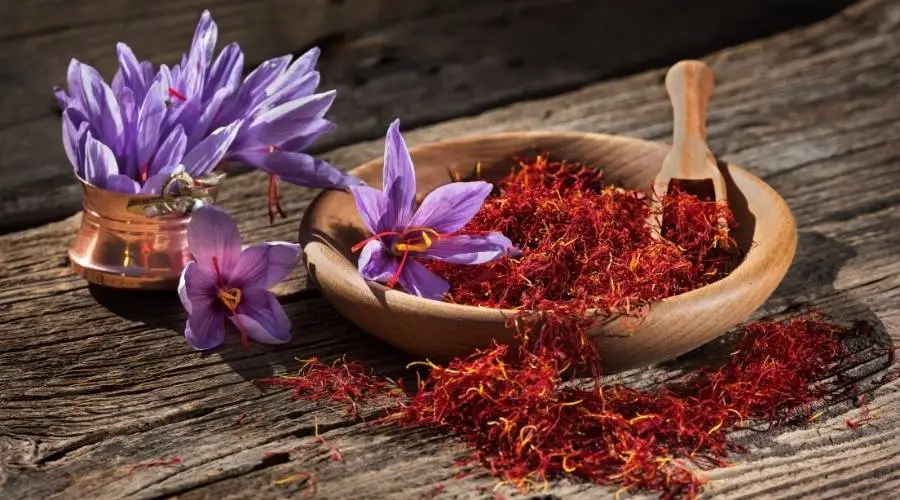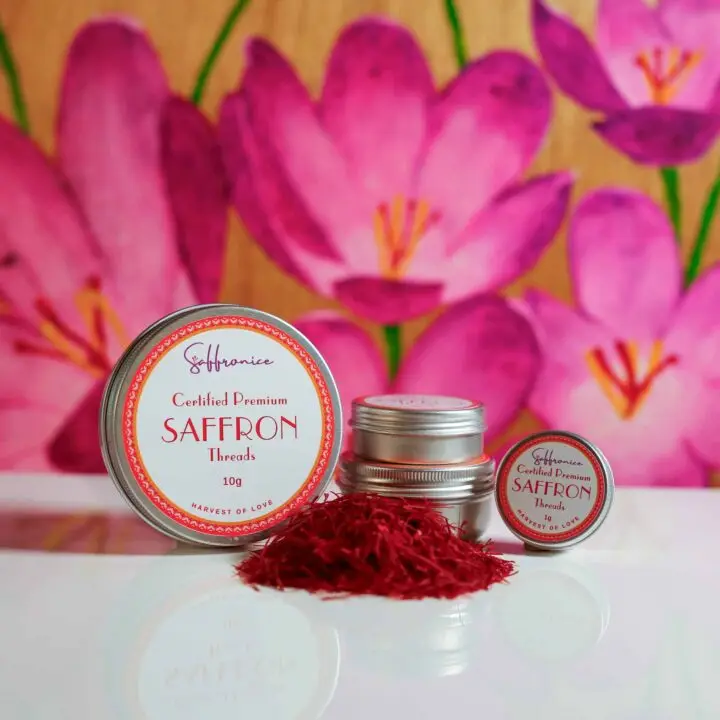📌 Quick Answer: Saffron holds profound spiritual significance across major world religions – representing purity and enlightenment in Hinduism, mindfulness and detachment in Buddhism, and courage and sacrifice in Sikhism. This sacred spice has been used in religious ceremonies, healing rituals, and spiritual practices for over 4,000 years across diverse cultures and civilizations.
Understanding Saffron’s Sacred Origins {#sacred-origins}
Saffron, often referred to as “red gold,” transcends its reputation as the world’s most expensive spice to occupy a revered position in spiritual and religious traditions worldwide. Carefully harvested from the delicate stigmas of Crocus sativus, each golden thread carries within it centuries of sacred tradition, mystical symbolism, and divine connection.
The spiritual journey of saffron begins with its very essence – a spice so precious that it requires 150 flowers to produce just one gram. This labor-intensive process has historically connected saffron with concepts of sacrifice, dedication, and the divine effort required for spiritual enlightenment.
Chef’s Cultural Insight: Having worked with saffron across different cultural contexts for decades, I’ve witnessed firsthand how its preparation becomes a meditation in itself. The gentle soaking of threads, the gradual release of color and aroma – these simple acts transform cooking into a sacred ritual that honors ancient traditions.
In places of worship spanning temples, mosques, monasteries, and sacred gathering spaces worldwide, saffron’s presence signifies moments of profound reverence. Its intoxicating fragrance mingles with incense smoke, prayers, and chanted mantras, creating an atmosphere where the earthly meets the divine. Understanding the history and origins of saffron reveals how this precious spice became interwoven with humanity’s deepest spiritual aspirations.
The golden hue of saffron has long been associated with divine light, solar energy, and spiritual illumination. Ancient texts across cultures describe saffron as a bridge between the physical and spiritual realms, a conduit through which devotees could access higher states of consciousness and divine blessing.

Spiritual Symbolism Across World Religions {#religious-symbolism}
Hinduism: Purity and Divine Knowledge
In Hindu tradition, saffron embodies the highest spiritual ideals of purity, wisdom, and inner enlightenment. The sacred color, known as “bhagwa” or “kesaria,” adorns the foreheads of devotees as a tilaka during religious ceremonies, symbolizing the third eye’s awakening and the pursuit of divine knowledge.
Sacred Hindu texts describe saffron as the color of Agni (fire), representing the burning away of ego and worldly attachments. During major festivals like Diwali and Holi, saffron-infused sweets and drinks serve not merely as culinary delights but as prasadam (blessed food) that carries spiritual vibrations from deity to devotee.
Spiritual Applications in Hinduism:
- Temple ceremonies: Saffron water purifies sacred spaces and offerings
- Meditation practices: Saffron-scented oils enhance concentration and spiritual awareness
- Ayurvedic rituals: Saffron in Ayurveda balances the doshas and promotes spiritual clarity
- Sacred markings: Tilaka made with saffron paste connects devotees to divine consciousness
Buddhism: Mindfulness and Detachment
Buddhist monasticism embraces saffron as a symbol of mindfulness, humility, and renunciation of worldly desires. The deep saffron robes worn by Theravada monks represent their commitment to the Middle Path and liberation from suffering through mindful living.
The color choice holds profound meaning – neither the white of householder’s clothing nor the deep ochre of ascetic’s garments, but a middle tone representing balanced spiritual practice. Each thread of saffron dye reminds monks of the impermanence of material existence and the importance of cultivating inner peace.
Buddhist Sacred Practices:
- Robe consecration: Saffron dye transforms simple cloth into sacred vestments
- Meditation rituals: Saffron incense creates conducive environments for mindfulness practice
- Temple offerings: Saffron-colored flowers and foods honor the Three Jewels
- Spiritual teachings: The saffron color serves as a visual reminder of core Buddhist principles
Sikhism: Courage and Sacrifice
Sikhism reveres saffron as the color of sacrifice, courage, and spiritual warriorhood. The kesari (saffron) shade prominently displayed on Sikh flags, turbans, and religious emblems symbolizes the willingness to defend truth and justice, even at great personal cost.
The Nishan Sahib (Sikh flag) flies in saffron as a beacon of spiritual courage, reminding the community of their duty to protect the innocent and uphold righteous principles. This symbolism connects directly to Guru Gobind Singh’s teachings about the Khalsa’s role as spiritual warriors.
Sikh Spiritual Symbolism:
- Religious flags: Kesari color represents spiritual valor and sacrifice
- Turban significance: Saffron turbans are worn during religious ceremonies
- Gurdwara decorations: Sacred spaces adorned with saffron-colored fabrics
- Festival celebrations: Saffron-hued foods served during religious gatherings
Ancient Civilizations and Sacred Traditions {#ancient-traditions}
Persian Zoroastrian Legacy
Ancient Persia’s connection to saffron runs deeper than mere cultivation – it represents a spiritual relationship with Ahura Mazda, the supreme deity of Zoroastrianism. Persian priests believed saffron threads contained concentrated sunlight, making them powerful conduits for divine fire ceremonies.
Zoroastrian fire temples employed saffron-infused oils and incense during ritual purifications, believing the spice’s golden essence could cleanse both physical spaces and spiritual auras. The Persian saffron cuisine tradition we know today evolved from these sacred ceremonial preparations.
Ancient Persian Sacred Uses:
- Fire ceremonies: Saffron offerings to sacred flames
- Royal coronations: Saffron water blessed new rulers
- Seasonal festivals: Nowruz celebrations featured saffron-infused foods
- Burial rites: Saffron preserved bodies and blessed the deceased’s journey
Egyptian Mystery Schools
Ancient Egyptian civilization elevated saffron to divine status, associating it with Ra, the sun god, and incorporating it into mystery school initiations. Cleopatra’s legendary saffron baths served not merely cosmetic purposes but represented ritual purification before communing with deities.
Egyptian priests used saffron in mummification processes, believing its preservative properties extended beyond physical preservation to spiritual protection in the afterlife. Temple walls depicted saffron offerings to gods, demonstrating its role as a bridge between earthly and divine realms.
Egyptian Sacred Applications:
- Mystery initiations: Saffron anointing oils for spiritual awakening
- Temple ceremonies: Golden threads offered to sun deities
- Royal preparations: Sacred baths before important rituals
- Afterlife protection: Saffron-infused substances for spiritual preservation
Greek and Roman Divine Connections
Classical antiquity recognized saffron’s divine associations through myths linking it to gods and heroes. Greek mystery cults incorporated saffron into Dionysiac rituals, while Roman ceremonies honored Bacchus with saffron-infused wine representing divine intoxication and spiritual ecstasy.
The cultural significance of saffron in these civilizations established patterns that continue influencing modern spiritual practices across Mediterranean cultures.
Culinary Sacred Practices {#culinary-practices}
Mediterranean Sacred Feasting
Mediterranean cultures transform saffron cooking into sacred acts of community devotion. Spanish paella preparation during religious festivals becomes a communal prayer, with each golden grain representing gratitude for divine provision. The careful cooking with saffron techniques passed down through generations preserves not just flavor but spiritual intention.
Sacred Mediterranean Preparations:
- Festival paella: Community gatherings honoring patron saints
- Bouillabaisse ceremonies: Fishermen’s blessings before sailing seasons
- Risotto celebrations: Northern Italian harvest thanksgiving rituals
- Easter breads: Saffron-golden loaves symbolizing resurrection light
Middle Eastern Ceremonial Cuisine
Middle Eastern cultures elevate saffron-infused dishes to ceremonial status during religious observances. The preparation of saffron rice dishes becomes a meditative practice, with each grain representing prayers offered to Allah. Sufi traditions particularly embrace saffron’s consciousness-altering properties during spiritual gatherings.
Ceremonial Middle Eastern Dishes:
- Wedding biryani: Saffron symbolizing prosperity and joy
- Ramadan breaking fasts: Golden rice representing divine blessing
- Pilgrimage preparations: Saffron foods for spiritual journey strength
- Sufi gathering foods: Consciousness-enhancing saffron preparations
Persian Spiritual Cuisine
Persian culinary traditions seamlessly blend saffron’s spiritual and gastronomic qualities. The preparation of traditional dishes like Zereshk Polo and Tahdig involves ritual-like precision, honoring both ancestors and divine providence. These practices maintain connections to ancient medicine traditions that viewed cooking as healing.
Sacred Beverages and Spiritual Drinks {#sacred-beverages}
Saffron Tea Ceremonies
Across cultures, saffron tea preparation and consumption transcend simple beverage making to become a spiritual practice. The delicate threading, gentle steeping, and mindful sipping create opportunities for meditation and spiritual reflection.
Traditional Tea Ceremony Elements:
- Mindful preparation: Each step performed with conscious intention
- Sacred timing: Brewing aligned with prayer times or spiritual practices
- Community sharing: Group ceremonies fostering spiritual connection
- Healing intentions: Tea prepared for specific spiritual or emotional needs
Sacred Milk Preparations
Golden milk and saffron-infused dairy preparations hold special significance in spiritual traditions. These saffron beverages serve as comfort foods during religious fasts and meditation retreats, providing both physical nourishment and spiritual sustenance.
Dessert Sacred Traditions
Saffron desserts occupy central positions in religious celebrations worldwide. From Persian rice puddings offered during religious holidays to Indian sweets distributed as prasadam, these golden confections carry blessings and spiritual significance beyond their culinary appeal.
Spiritual Healing and Energy Work {#spiritual-healing}
Energy Channeling Properties
Contemporary energy healers and spiritual practitioners recognize saffron’s capacity to amplify positive vibrations and facilitate spiritual transformation. The spice’s high vibrational frequency allegedly aligns with solar plexus and crown chakras, supporting both personal power and spiritual connection.
Modern Energy Work Applications:
- Chakra balancing: Saffron oils applied to energy centers
- Aura cleansing: Saffron incense for spiritual purification
- Meditation enhancement: Saffron aromatherapy supporting deeper states
- Crystal charging: Saffron water blessing healing stones
Protective Spiritual Qualities
Many traditions credit saffron with protective properties against negative energies and psychic attacks. Practitioners incorporate saffron into spiritual cleansing rituals, believing its golden essence creates energetic barriers while attracting positive influences.
The mood regulation properties of saffron support emotional stability during spiritual work, helping practitioners maintain centered states while engaging in intensive spiritual practices.
Consciousness Expansion
Spiritual seekers across traditions report enhanced states of consciousness when incorporating saffron into meditation practices. While not psychoactive in the conventional sense, saffron’s subtle influence on neurotransmitter systems may support expanded awareness and spiritual insight.
Modern Spiritual Applications {#modern-applications}
Contemporary Spiritual Practices
Modern spiritual movements continue embracing saffron’s sacred qualities while adapting ancient practices to contemporary contexts. New Age practitioners incorporate saffron into crystal healing, astrology work, and manifestation rituals, honoring traditional uses while exploring innovative applications.
Modern Integration Methods:
- Essential oil blends: Saffron combined with frankincense and myrrh
- Spiritual baths: Saffron-infused water for energetic cleansing
- Ritual candles: Saffron-scented candles for sacred space creation
- Meditation tools: Saffron-dyed malas and prayer beads
Holistic Healing Integration
Contemporary holistic healing practices recognize saffron’s multi-dimensional therapeutic properties. Practitioners combine traditional spiritual applications with modern understanding of saffron’s biochemical effects on mood, cognition, and overall well-being.
Interfaith Spiritual Practices
Modern interfaith communities appreciate saffron’s universal spiritual symbolism, using it as a unifying element in diverse worship settings. This inclusive approach honors multiple traditions while creating shared sacred experiences.

Sacred Preparation Methods {#preparation-methods}
Traditional Extraction Techniques
Sacred saffron preparation requires reverence, patience, and mindful attention to detail. Traditional methods passed down through generations preserve not just potency but spiritual intention embedded in each step.
Sacred Preparation Protocol:
- Intention Setting: Begin with prayer or meditation
- Mindful Selection: Choose threads with conscious appreciation
- Gentle Soaking: Use warm (not boiling) blessed water
- Patient Waiting: Allow 15-20 minutes for full extraction
- Grateful Usage: Apply with conscious appreciation
Chef’s Spiritual Cooking Wisdom: The key to spiritual saffron preparation lies not in technique alone but in the intention and reverence brought to each step. When we honor saffron’s sacred nature, it responds by releasing its fullest spiritual and culinary potential.
Modern Quality Considerations
Contemporary spiritual practitioners must navigate quality concerns when sourcing saffron for sacred use. Understanding saffron quality standards ensures authentic spiritual experiences while supporting traditional cultivation communities.
Proper saffron storage methods preserve both potency and spiritual energy, maintaining the spice’s sacred qualities over time. Sourcing from reputable suppliers supports authentic spiritual practice while honoring traditional producers.
Cultural Significance and Festivals {#cultural-significance}
Global Festival Integration
Saffron’s presence in cultural celebrations worldwide demonstrates its universal appeal as a symbol of joy, prosperity, and spiritual blessing. From Indian Diwali celebrations to Spanish Easter processions, saffron marks moments of collective spiritual significance.
Major Festival Applications:
- Hindu Festivals: Diwali sweets and Holi celebrations
- Islamic Observances: Ramadan breaking fasts and Eid feasting
- Christian Ceremonies: Easter bread and Christmas specialties
- Sikh Gatherings: Langar meals and Vaisakhi celebrations
- Buddhist Occasions: Vesak Day offerings and meditation retreats
Regional Sacred Traditions
Different regions have developed unique sacred applications reflecting local spiritual needs and cultural values. These variations demonstrate saffron’s adaptability while maintaining core spiritual significance across diverse contexts.
Contemporary Revival Movements
Modern revival movements seek to restore traditional saffron spiritual practices within contemporary contexts. These efforts honor ancestral wisdom while making ancient practices accessible to modern practitioners.
Expert Insights on Sacred Usage {#expert-insights}
Spiritual Practitioner Perspectives
Contemporary spiritual teachers emphasize saffron’s role as a catalyst for deeper spiritual experience rather than a source of spiritual power itself. The spice serves as a focusing tool, helping practitioners access states of consciousness already present within.
Spiritual Teacher’s Guidance: “Saffron doesn’t create spiritual experiences – it removes obstacles preventing us from recognizing our inherent divine nature. Its golden light reflects the light already shining within each soul.”
Cultural Preservation Importance
Maintaining traditional saffron spiritual practices preserves invaluable cultural wisdom while supporting communities that have cultivated both spice and spiritual traditions for millennia. This preservation benefits both spiritual seekers and traditional communities.
Integration with Modern Life
Successfully integrating saffron’s sacred qualities into modern life requires balance between honoring tradition and adapting to contemporary circumstances. Simple daily practices can maintain spiritual connection without requiring extensive ceremonial preparation.
Practical Daily Integration:
- Morning intention: Adding saffron to tea with grateful prayer
- Meal blessing: Consciously appreciating saffron-enhanced dishes
- Evening reflection: Saffron aromatherapy supporting meditation
- Weekly ceremony: Dedicated time for traditional preparation methods
Frequently Asked Questions {#faqs}
Q: What is the spiritual significance of saffron across different world religions? A: Saffron holds profound spiritual meaning across major world religions. In Hinduism, it represents purity, wisdom, and spiritual enlightenment. Buddhism associates saffron with mindfulness, detachment, and the middle path. Sikhism views saffron as symbolizing courage, sacrifice, and spiritual warrior-hood. These diverse interpretations demonstrate saffron’s universal appeal as a symbol of higher spiritual ideals.
Q: How can I incorporate saffron into modern spiritual practices? A: Modern spiritual incorporation can be simple yet meaningful. Add saffron to meditation teas, use saffron-scented oils during prayer, incorporate golden threads into altar decorations, or prepare saffron-infused foods with conscious intention. The key lies in approaching these practices with reverence and mindful awareness rather than elaborate ceremony.
Q: What are the traditional sacred preparation methods for spiritual saffron use? A: Traditional preparation emphasizes mindful intention throughout the process. Begin with meditation or prayer, select threads with conscious appreciation, soak in warm blessed water for 15-20 minutes, and use the resulting liquid with grateful awareness. This method preserves both spiritual energy and practical potency.
Q: Can saffron enhance meditation and spiritual practices? A: Many practitioners report that saffron’s subtle aromatherapeutic properties and consciousness-supporting compounds enhance meditation depth and spiritual clarity. While individual experiences vary, saffron’s traditional use across cultures suggests genuine benefits for contemplative practices.
Q: What should I know about sourcing saffron for spiritual purposes? A: Quality matters significantly for spiritual applications. Source from reputable suppliers offering authentic, laboratory-tested saffron. Support traditional cultivation communities when possible, as this maintains the spiritual lineage connecting modern practice to ancient traditions. Store properly to preserve both potency and energetic qualities.
Q: How do ancient spiritual traditions inform modern saffron usage? A: Ancient traditions provide blueprints for respectful, effective saffron integration. They emphasize reverent preparation, conscious intention, community sharing, and grateful appreciation. Modern practitioners can adapt these principles to contemporary contexts while honoring the wisdom embedded in traditional practices.
🔑 Key Takeaways
- Universal spiritual symbol: Saffron transcends cultural boundaries, representing purity, enlightenment, and divine connection across multiple world religions and spiritual traditions
- Ancient sacred heritage: Over 4,000 years of documented spiritual use across civilizations from Persia to Egypt to Greece establishes saffron’s profound spiritual significance
- Multi-dimensional applications: From ceremonial cooking to meditation enhancement, saffron serves diverse spiritual functions while maintaining core symbolic meanings
- Quality enables authenticity: Genuine spiritual experiences require authentic saffron sourced from reputable suppliers and prepared with traditional reverence
- Modern accessibility: Contemporary practitioners can honor ancient wisdom while adapting traditional practices to modern lifestyles through simple, mindful integration
- Community connection: Saffron’s spiritual significance strengthens when shared within communities that honor both culinary and sacred traditions
Transform your spiritual practice with saffron’s sacred wisdom – honoring ancient traditions while embracing the golden thread that connects humanity’s deepest spiritual aspirations across cultures, centuries, and continents.



